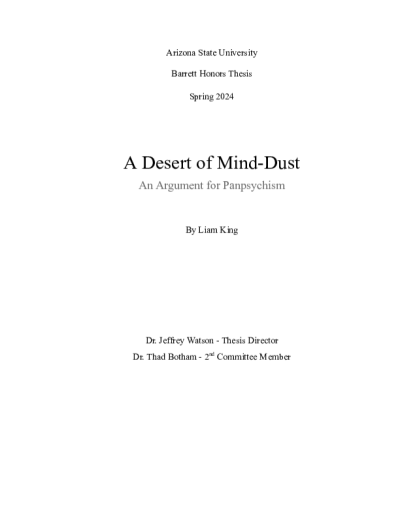Filtering by
- Creators: School of Molecular Sciences
- Resource Type: Text

Background: Staphylococcus aureus and S. epidermidis biofilms differ in structure, growth and regulation, and thus the high-throughput method of evaluating biofilm susceptibility that has been published for S. epidermidis cannot be applied to S. aureus without first evaluating the assay's reproducibility and reliability with S. aureus biofilms.
Methods: Staphylococcus aureus biofilms were treated with eleven approved antibiotics, lysostaphin, or Conflikt®, exposed to the oxidation reduction indicator Alamar blue, and reduction relative to untreated controls was determined visually and spectrophotometrically. The minimum biofilm inhibitory concentration (MBIC) was defined as ≤ 50% Alamar blue reduction and a purple/blue well 60 min after the addition of Alamar blue. Because all of the approved antibiotics had MBICs >128 μg/ml (most >2048 μg/ml), lysostaphin and Conflikt®, with relatively low MBICs, were used to correlate Alamar blue reduction with 2,3-bis(2-methoxy-4-nitro-5-sulfophenyl)-2H-tetrazolium-5-carboxanilide (XTT) reduction and viable counts (CFU/ml) for S. aureus ATCC 29213 and three clinical isolates. Alamar blue's stability and lack of toxicity allowed CFU/ml to be determined from the same wells as Alamar blue absorbances.
Results: Overall, Alamar blue reduction had excellent correlation with XTT reduction and with CFU/ml. For ATCC 29213 and two clinical isolates treated with lysostaphin or Conflikt®, Alamar blue reduction had excellent correlation with XTT reduction (r = 0.93-0.99) and with CFU/ml (r = 0.92-0.98). For one of the clinical isolates, the results were moderately correlated for Conflikt® (r = 0.76, Alamar blue vs. XTT; r = 0.81, Alamar blue vs. CFU/ml) and had excellent correlation for lysostaphin (r = 0.95, Alamar blue vs. XTT; r = 0.97, Alamar blue vs. CFU/ml).
Conclusion: A reliable, reproducible method for evaluating biofilm susceptibility was successfully applied to S. aureus biofilms. The described method provides researchers with a simple, nontoxic, relatively inexpensive, high throughput measure of viability after drug treatment. A standardized biofilm Alamar blue assay should greatly increase the rate of discovery of S. aureus biofilm specific agents.

Background:
Iron is an essential micronutrient for all organisms because it is a component of enzyme cofactors that catalyze redox reactions in fundamental metabolic processes. Even though iron is abundant on earth, it is often present in the insoluble ferric [Fe (III)] state, leaving many surface environments Fe-limited. The haploid green alga Chlamydomonas reinhardtii is used as a model organism for studying eukaryotic photosynthesis. This study explores structural and functional changes in PSI-LHCI supercomplexes under Fe deficiency as the eukaryotic photosynthetic apparatus adapts to Fe deficiency.
Results:
77K emission spectra and sucrose density gradient data show that PSI and LHCI subunits are affected under iron deficiency conditions. The visible circular dichroism (CD) spectra associated with strongly-coupled chlorophyll dimers increases in intensity. The change in CD signals of pigments originates from the modification of interactions between pigment molecules. Evidence from sucrose gradients and non-denaturing (green) gels indicates that PSI-LHCI levels were reduced after cells were grown for 72 h in Fe-deficient medium. Ultrafast fluorescence spectroscopy suggests that red-shifted pigments in the PSI-LHCI antenna were lost during Fe stress. Further, denaturing gel electrophoresis and immunoblot analysis reveals that levels of the PSI subunits PsaC and PsaD decreased, while PsaE was completely absent after Fe stress. The light harvesting complexes were also susceptible to iron deficiency, with Lhca1 and Lhca9 showing the most dramatic decreases. These changes in the number and composition of PSI-LHCI supercomplexes may be caused by reactive oxygen species, which increase under Fe deficiency conditions.
Conclusions:
Fe deficiency induces rapid reduction of the levels of photosynthetic pigments due to a decrease in chlorophyll synthesis. Chlorophyll is important not only as a light-harvesting pigment, but also has a structural role, particularly in the pigment-rich LHCI subunits. The reduced level of chlorophyll molecules inhibits the formation of large PSI-LHCI supercomplexes, further decreasing the photosynthetic efficiency.

Viral protein U (Vpu) is a type-III integral membrane protein encoded by Human Immunodeficiency Virus-1 (HIV- 1). It is expressed in infected host cells and plays several roles in viral progeny escape from infected cells, including down-regulation of CD4 receptors. But key structure/function questions remain regarding the mechanisms by which the Vpu protein contributes to HIV-1 pathogenesis. Here we describe expression of Vpu in bacteria, its purification and characterization. We report the successful expression of PelB-Vpu in Escherichia coli using the leader peptide pectate lyase B (PelB) from Erwinia carotovora. The protein was detergent extractable and could be isolated in a very pure form. We demonstrate that the PelB signal peptide successfully targets Vpu to the cell membranes and inserts it as a type I membrane protein. PelB-Vpu was biophysically characterized by circular dichroism and dynamic light scattering experiments and was shown to be an excellent candidate for elucidating structural models.



Panpsychism is the view that consciousness is an intrinsic state of the world. While early forms were advanced by Spinoza and Russell, only recently has panpsychism gained widespread academic consideration. In this paper, I will argue for panpsychism, based on a similarity of the nature of our consciousness with the nature of the parts of our consciousness. This argument will be motivated by an anti-strong emergentist viewpoint, while allowing for complex consciousness to arise from a form of weak emergence between fundamental parts. Ultimately, this argument demonstrates that an identity theorist would collapse to panpsychism or strong emergentism, the former being preferred. From this, I argue that panpsychists can gain some intuitive benefits of dualism and materialism, without inheriting their issues. This positions the panpsychist well to respond to issues like Jackson’s (1982) Mary-argument. I will then discuss possible objections to panpsychism, focusing primarily on the combination problem. I conclude that the co-consciousness strategy is the optimal solution to this problem and can account for the inverse issue of the decombination problem that cosmopsychism faces. Overall, panpsychism’s explanatory power and compatibility with other disciplines makes it a favorable theory within the philosophy of mind.
